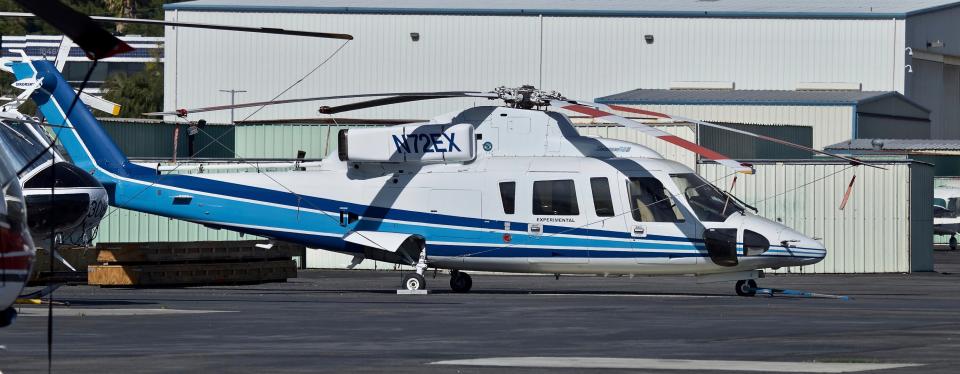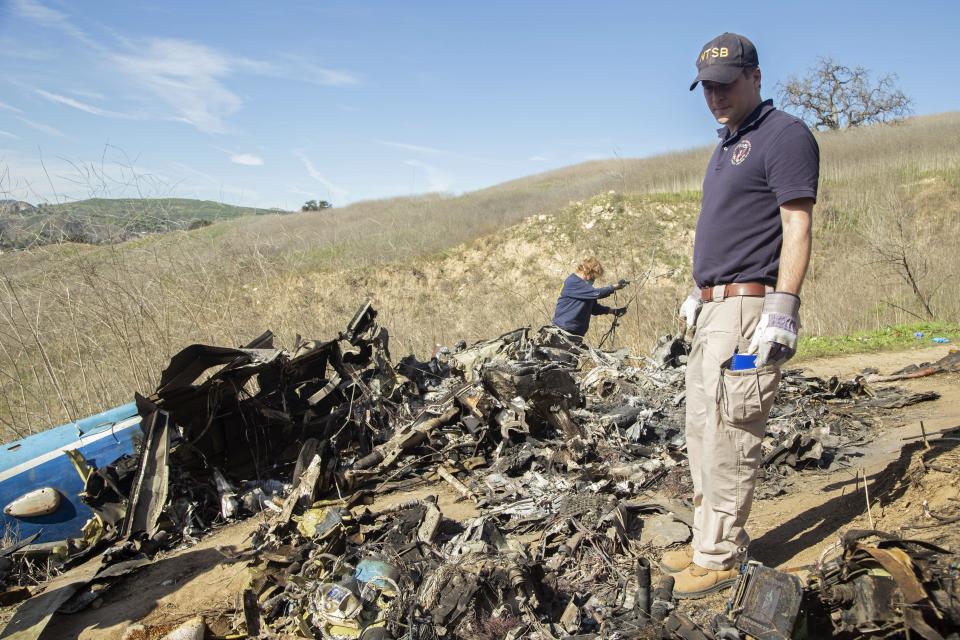How this helicopter safety device might have saved Kobe Bryant and eight others
LOS ANGELES – When fog closes in, it can be deadly for helicopter pilots.
"Everything goes bad really fast," said Coyt Bailey, a veteran helicopter pilot based in Flowood, Mississippi, about those who become disoriented in the clouds, lose sight of the ground and horizon, then crash.
Whether spatial disorientation played a role in the accident that killed Kobe Bryant, his 13-year-old daughter Gianna and seven others is yet to be determined. It's one possibility among several. But the National Transportation Safety Board, investigating the crash Sunday on a rugged hillside northwest of Los Angeles in Calabasas, California, is clear about one thing: Technology might have saved the retired NBA superstar, the pilot and passengers.
The big Sikorsky S-76B wasn't equipped with a Terrain Awareness and Warning System, or TAWS, a device that warns pilots of mountains hiding in the mist ahead, NTSB board member Jennifer Homendy said.
On Thursday, a congressman from Los Angeles proposed requiring them on all helicopters. U.S. Rep. Brad Sherman, a Democrat, said they will be a key feature of his Kobe Bryant and Gianna Bryant Helicopter Safety Act that he will introduce.
NTSB has included TAWS on its "most wanted list" for regulatory actions starting in 2008. The Federal Aviation Administration relented when it comes to air ambulance helicopters, but it did not extend the requirement to large passenger-carrying choppers like the one ferrying the Bryant party about 90 miles to a girls' basketball tournament.
NTSB: 'Single most important' device
"TAWS is considered by many in the airplane safety community as the single most important safety device introduced to prevent commercial fatal accidents in the last 20 years," the FAA acknowledged in a 2012 report.
Veteran pilots say TAWS is a terrific aid in certain conditions. It can be effective for a situation like the one that faced Bryant's pilot, Ara Zobayan, on a journey that transitioned from an expanse of mostly flat terrain to hills and mountains. Where TAWS isn't terribly effective is for pilots working continuously in conditions where its audible alarm is constantly triggered.
"Terrain awareness has its place, but it's not a silver bullet," said Bryan Smith, safety program manager for the Airborne Public Safety Association and himself a working copter pilot. Those who fly helicopters in hilly areas know "you start building a tolerance to the alerts."
If the system cries wolf too many times under those circumstances, pilots may either shut off the alarm or not take it seriously the one time that it could save lives.
The debate over the systems' value has carried over to the nation's two most important aviation safety agencies, the FAA, which makes and enforces regulations, and NTSB, which investigates accidents and recommends improvements.

The FAA says that through the end of 2018, it had accepted about 75% of the NTSB's recommendations. As a matter of course, the FAA says it formally reviews and replies to every one of them. But sometimes the two agencies disagree.
Their dispute over terrain warning systems erupted after a Sikorsky S-76A crashed in 2004 during a night flight over the Gulf of Mexico, killing the pilot, co-pilot and eight oil industry workers. The NTSB concluded that the accident might have been avoided if the aircraft had been equipped with TAWS. The agency recommended the FAA issue a requirement for all turbine-powered helicopters with six or more passenger seats to be equipped with the device.
Pilots might disregard 'nuisance alarms'
The FAA, in response, raised the issue of "nuisance alarms" and the specter that pilots might disregard them but eventually decided to require TAWS in air-ambulance copters because they fly night missions and often must land in remote and risky locations.
More: In his last sit-down interview, Kobe shared what daughter Gigi loved about basketball
In rejecting NTSB pleas to extend the TAWS requirement to large passenger-carrying choppers, opponents not only cited the nuisance-alarm problem but costs. Systems can run about $20,000 and upwards of $35,000 per aircraft. Then-FAA Administrator Michael Huerta said he was considering a new rule as late as 2012, but no action was taken. NTSB closed its recommendation two years later, noting the FAA's "unacceptable" decision.
TAWS does not guarantee crash prevention. Three years ago, a medical flight in Alabama took off on a rainy, misty night to rescue an accident victim. The aircraft "was equipped with a helicopter terrain avoidance warning system, a night vision imaging system which included night-vision goggles, and an autopilot," a report said. Yet it slammed into trees, killing the pilot and passengers.

NTSB investigators said the accident resulted from the pilot’s decision to fly in unsafe conditions, "which resulted in loss of control due to spatial disorientation. Contributing to the accident was the pilot's self-induced pressure to complete the mission."
It's that can-do attitude, Bailey said, that kills pilots.
Bailey, a veteran pilot, compared it to trying to pass a slow car on a two-lane highway and realizing you may not beat an oncoming vehicle. "Ninety-nine times out of 100, you may make it. But the one time you don't, it's a head-on collision at 130 mph," he said.
More: Kobe Bryant crash could lead to safer helicopters: TAWS, black boxes back in play
As low visibility enveloped the luxury Sikorsky ferrying Bryant, his pilot may have been lured into thinking he could tough it out and avoid embarrassment in front of a celebrity client, observers say. Bailey said the thought process might have been, "If I can make it through this pass, it's going to open back up again. ... I don't want to be the guy who makes Kobe Bryant miss coaching his kid's basketball team."
People the cause of most chopper crashes
When they suddenly fly into bad weather, copter pilots call it "going IMC," for instrument meteorological conditions. Wise ones will turn back, transition from flying based on what they can see to what their instruments are telling them, ask air traffic controllers to direct them to an airport or simply set down on an empty beach, field or mountaintop. "It doesn't matter if it's in the governor's backyard," said Ben Fouts, a 22-year helicopter pilot in Hawaii.
As a young aviator, Fouts said he was co-piloting a Sikorsky in the Gulf of Mexico as the weather worsened. His passengers, a group of oil company executives, grew irate when the captain decided to abort the trip, but he didn't back down.
"I learned right then, there are some flights you just don't take," he said. "In my school, we tell student pilots, 'Listen guys, be the first chicken in the sky.'"
Airplanes also can fly into trouble and have to keep continuously moving. But helicopter pilots can't simply hover their way out of trouble. Trying to hold a position in the sky, especially in conditions where surrounding terrain is obscured, is one of the toughest skills a pilot can learn.
"It's like riding a unicycle with a blindfold while juggling chainsaws," pilot Smith said.
More: Kobe Bryant's body, 8 others recovered from helicopter that lacked key terrain warning system
The fatality rate in U.S. rotorcraft accidents has been cut in half during the past two decades, according to the United States Helicopter Safety Team, a volunteer group of industry and government leaders. Deaths per 100,000 trips declined from 1.27 in 2005 to 0.63 last year. To reduce them, the group has been striving to boost industry education and to focus issues identified as the biggest cause of accidents.
It's usually people, not machines, who are to blame.

Human error causes about four out of every five accidents, said Julianne Fox, a veteran pilot, flight instructor and consultant for Decision Speed. That error can be subtle – until it's too late. Bryant's pilot, for instance, might have been trying to fly beneath the cloud cover but the ground level was gradually rising, basically trapping him in a situation in which he had to enter the clouds.
Investigators searching the wreckage have found that the pilot, Zobayan, had an iPad aboard that contained a program with terrain mapping software, but it's not clear how much it would have helped if he flew into heavy clouds.
That's because for all pilots, technology alone is never enough to save them if they get themselves into hairy situations.
"The truth is, it doesn't matter how much safety equipment we have if people are goingto do stupid stuff," said Pia Bergqvist, an airplane pilot and senior editor at Flying Magazine.
This article originally appeared on USA TODAY: Kobe Bryant crash: This helicopter safety tech could have saved him

